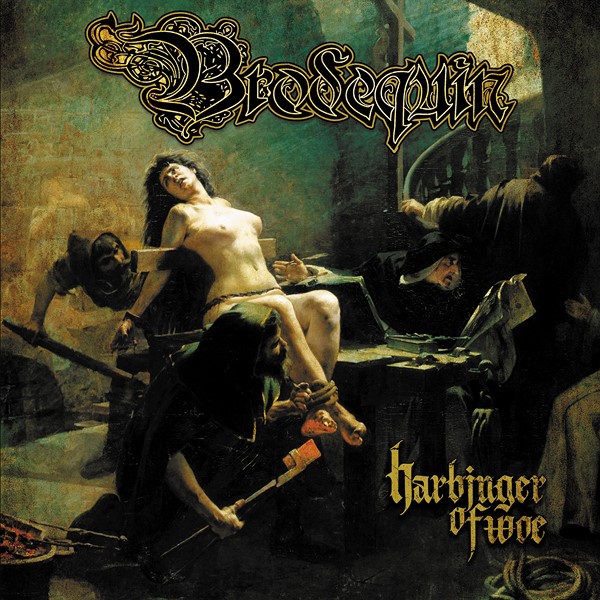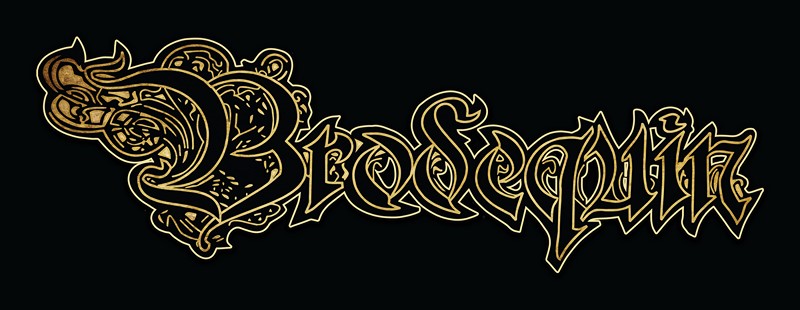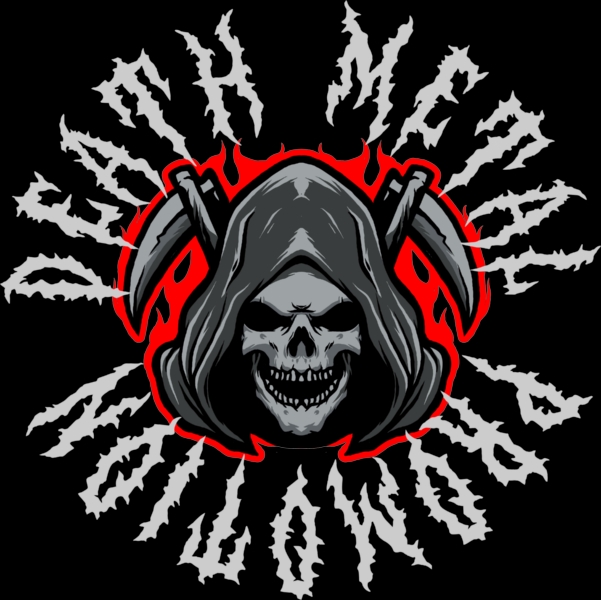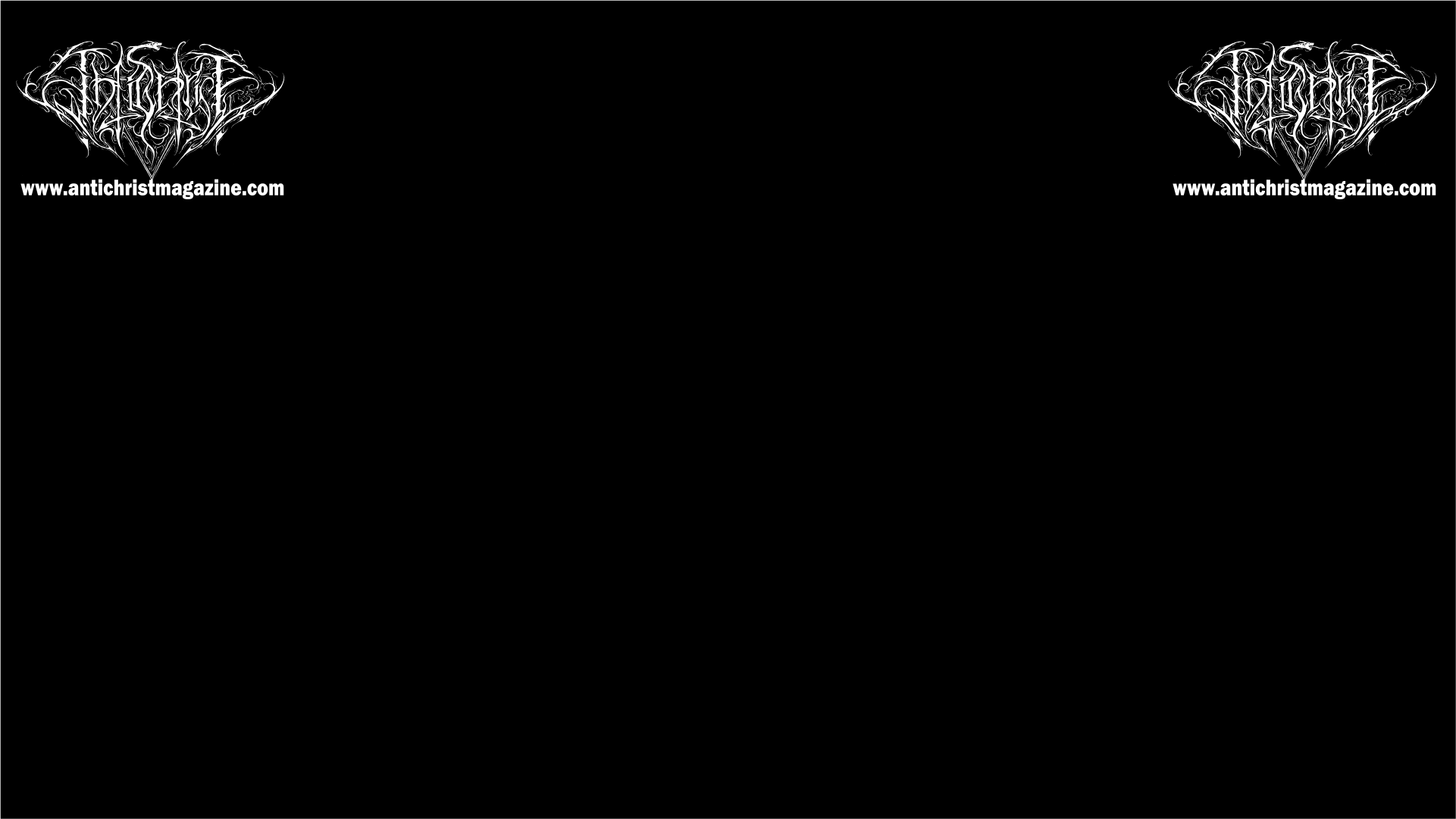
Hi guys! What inspired Brodequin‘s return after a 20-year hiatus, and how does it feel to be back?
Jamie Bailey: Hello! We never wanted or planned to take such a break, it was just something that ended up happening and went on a little longer than we anticipated. It feels great to be back, we had some early challenges that came with it, but everyone has been extremely supportive.
Can you delve deeper into the inspiration behind “Of Pillars and Trees” and its significance within the album?
Jamie Bailey: As many are aware we more or less specialize in portraying historical torture and execution methods. “Of Pillars and Trees” is no exception to this.
The genesis of “Of Pillars and Trees” finds its inspiration in the historical practices that involved the utilization of trees for the purpose of torture and ultimately, execution. Among the myriad methods employed, a prominent example was the affixing of an individual to a pillar or, more commonly, a tree trunk through the use of long iron nails. This form of restraint could manifest with the person either elevated or at ground level, exposed not only to the elements but also vulnerable to the presence of wildlife and the torment of onlooking spectators.
An alternative method involved the utilization of tree limbs, particularly those of young and flexible trees. By clustering several young trees or limbs together, it became possible to bend them and attach various body parts, such as arms and legs, individually. Upon release from the applied pressure, these trees or limbs would exert force, resulting in the immediate dislocation of limbs, tearing of tendons, or even shattering of bones. Conversely, a more protracted ordeal could be inflicted by gradually stretching the individual in different directions over the course of several days until death mercifully intervened.
The means of attachment to pillars or trees varied and included spikes of diverse forms, ropes, or large wooden rings. According to historical accounts, some instances involved the burning of trees with the victim still affixed, while others detailed the bodies left hanging until the forces of weather disintegrated them.
In a noteworthy historical example, Saint Paphnutius reportedly suffered martyrdom in a similar fashion. Under the directive of Diocletian, Saint Paphnutius was purportedly crucified on a date tree, exemplifying the brutal convergence of human suffering and arboreal implements in antiquity.
How did you experiment with new elements while staying true to Brodequin’s signature sound in the creation process?
Jamie Bailey: It really was a natural process when it came to the material we have for the new album. Of course it’s always in the back of your head when it comes to blasting, heavy riffs etc., but the new songs all flowed together organically. We love to play fast, so the thought of not including the classics elements never crossed our minds. When it comes to the riff creation process Mike and I (Jamie) record nearly everything we come up with. In my case, Mike always is able to polish what I present to him and make it into something special.
We have a lot of different musical influences that many in the brutal death metal realm probably aren’t interested in. These influences naturally are going to make their way into our creation process and have certainly made themselves known on “Harbinger of Woe”. Listening back to the first three albums I think you can hear a progression in our approach to writing and presentation. This album is a continuation of right where we left off when we took a break.
Lyrically while maintaining the thematic focus on torture and execution, I attempted to traverse deeper and into more nuanced lyrical themes. The lyrics this time around on some of the songs, have elements from the victim’s point of view, or from the Inquisitor’s and or executioner’s. These sections are italicized in the lyrics.
By navigating these avenues of experimentation, we pushed our boundaries a bit while ensuring that the essence of our signature sound remains intact. It’s important for bands to evolve and explore, all while staying true to the unique elements that define their identity.
How does drawing from historical events, particularly the medieval period, influence Brodequin’s creative process and overall identity as a band?
Jamie Bailey: The medieval period comes with a unique aesthetic. This aesthetic, for us creates a visual identity that complements our musical and lyrical themes. Using these elements contributes to the band’s overall identity and helps separate us from the sheer amount of bands that are out there. Our fans appreciate the attention to detail and the exposure to pieces of art they may have never seen if not for us using it.
To me, the brutality involved in the subject matter we draw from has no comparable equivalent. It’s a natural source of inspiration for the music we create and the quality and distinctiveness we strive to achieve as a band.
How do you balance historical accuracy with artistic expression in your songwriting, particularly regarding themes like dismemberment and torture?
Jamie Bailey: When it comes to descriptions of torture/execution techniques or the equipment used to carry out these tasks, the descriptions are historically accurate in what texts and witnesses describe. There are very few “artistic” liberties I take when writing lyrics.
I see this as more of presenting facts in an artistic way. To me the accuracy is the most important, but so to, is telling it in a way that’s not something you may find in a typical history book. When dealing with topics such as we do there are certain to be gaps in information, incorrect information etc. There are many instances where historians disagree on what devices and torture techniques actually took place.
The Iron Maiden and The Blood Eagle are two examples that are often debated. Unless archaeologists find a corpse bearing clear evidence of the torture, we’ll likely never know. Breaking on the wheel is a case where we have discovered human remains that were executed in that fashion, so it’s absolutely possible to uncover evidence. All things considered, I still base my position on the historical documents that outline any given method.
There are cases where I help “paint a picture” of a scenario that there are many different points of view from. For example, “Of Pillars and Trees” is describing a process taking place from both the victim’s and observer’s points of view. In order to try and recreate the scene as descriptive as possible from documented eye witness accounts I need to “tell a story”. With “Harbinger of Woe” I may have been able to accomplish this more so than previous albums, that will be up to the fans to decide.
Can you discuss the juxtaposition of brutality and beauty throughout “Harbinger of Woe,” both musically and thematically?
Jamie Bailey: The juxtaposition of brutality and beauty in “Harbinger of Woe” speaks to the complexity of the human experience during the era we use as inspiration. It underscores how individuals sought to find and create amidst the challenges and harsh realities of medieval life. This era saw a complex interplay between violence, hardship, and the pursuit of artistic refinement.
“Harbinger of Woe” contains all these elements throughout lyrically and musically. The violence expressed in the lyrics, the brutality of the music with extreme contrasts in some cases and the craft taken in the artwork used. A couple of examples from the album that come to mind are Tenaillement and Theresiana. Both very poetic sounding, which conceals the violence that is associated with each of them. Every song on the album has these elements to one extent or another.
The album in its entirety has, in our opinion, a distinct beginning and end that allows certain elements to play out along the way. Depending on how into the lyrical concepts you are, the more or less impactful overall this will be will be to each individual listener.
What was the inspiration behind the title track, “Harbinger of Woe,” and how does it represent Brodequin’s essence?
Jamie Bailey: At its most basic “Harbinger of Woe” itself comes from the idea of a person bearing/delivering something negative.
harbinger; plural noun: harbingers
a person or thing that announces or signals the approach of another.
woe; interjection
1. : a condition of deep suffering from misfortune, affliction, or grief.
In many ways this is connected to the subject matter as a whole that we are presenting. There are several quotes used in “Harbinger of Woe” that capture the violence and mindset from that era that we try and express.
There is no doubt the lyrical content is full of suffering, misfortune and grief.
Lyrically, I portray an expert in his craft acquainted with all the negative aspects of his profession. Such as, being shunned from society for the most part, yet if you found yourself in such a horrible position, you would certainly want this highly skilled professional to put you down as quickly and efficiently as possible. The alternative would be butchery and prolonged suffering of which there is no shortage of historical accounts.
I like to think we provide a certain amount of an information based narrative from a time not so long ago. I have spent decades studying the topic, including time spent at the university focusing on this part of history. The artwork we collect and present, the subject matter and its delivery, I feel, in many ways are connected to what we are inspired by. There’s certainly a skill involved with that, and in fact brutal death metal is shunned from most society. Not only is the music looked down upon by many, but so too is the subject matter itself. A subject that one would think shouldn’t be forgotten for all that it represented and all that it influenced both positively and negatively.
So I feel that this track has a lot of essential elements that make us who we are, and what we represent in the realm of death metal.
Brennan, how did you approach joining Brodequin as the newest member, and what unique elements do you bring as a drummer?
Brennan Shackelford: I approached joining the band as a challenge to step up my playing ability to suit Brodequin’s needs. I knew that I could do it, but I felt that I needed to level up as a drummer to truly uphold the band’s legacy. There’s a tremendous amount of expectations placed on anyone who drums for this band. When I was asked, I started practicing 280 bpm blasting endurance every day to the point that the tendons and muscles in my hands were raw. It’s a rite of passage to be able to play this music which demands everything from you.
As far as unique elements as a drummer go, I bring a plethora of influences ranging from the death metal staples to the jazz inspired. I try to merge taste and finesse with power and speed within the music. One way that I do this is I match high and low pitches in Mike’s guitar riffs with accents on corresponding cymbals and drums to create a melodic sensibility while maintaining the blast beats and other Brodequin mainstays.
How did personal losses within your family shape your decision to step away from music and influence the creation of “Harbinger of Woe” upon your return?
Jamie Bailey: There was a period of time where Mike and I went through losing the vast majority of our family. Mike and I are all that’s left of the original family unit so to speak, no grandparents, parents, aunts or uncles and it was all over the course of a few years. Speaking for myself it was a fairly difficult time that took years to fully process, if I did indeed fully process it. It’s not something we have ever spoken publicly about as it’s a private matter, close friends knew of course. But in many ways looking back on it, we all go through challenges, and perhaps some readers are going through something similar at this time.
Once we felt we had the time and ability to come back we wanted to do so full force. It was simply impossible to put the energy into creating music while we were away. It wouldn’t have been a fair effort in releasing anything during that time.
“Harbinger of Woe” has all the elements we have utilized in the past; descriptions of torture/execution methods, crowd appreciation/witness records, judicial influences etc. But this time around I included some scholar quotations, and tried in some cases to throw a little bit more of back and forth between the torturer and victim. We feel that this album is right on par with our past efforts and that we were able to fully commit to the creation process. It’s totally possible that our experiences during our time away influenced some of the writing, as there are certainly new elements that we hadn’t explored before.
Can you discuss the collaboration process behind the visual representation of “Harbinger of Woe” in terms of album artwork?
Jamie Bailey: The art chosen for the cover is entitled The Martyr of Fanaticism by José de Brito. In respect to the collaboration aspect, we were able to obtain permission from the Museu de Chiado in Lisbon Portugal to use his work. This was a major step for us, as the museum recognized our dedication to presenting history accurately and in proper context. In many cases we never had the chance for our selections as there was no one to collaborate with. Past album cover artists have been lost to time, but in this case there was an opportunity to do something different. There are not too many bands I can think of that were able to work with a museum of art to accomplish their goal.
How do you perceive the evolution of Brodequin’s sound and brutality over the years, particularly with “Harbinger of Woe”?
Jamie Bailey: I really perceive it as a natural progression from a few angles. One, the more you write the more you will become comfortable with certain aspects which will naturally lead to trying to push some boundaries. Second, technology has improved greatly since our early albums which allow for the listener to hear more of what’s going on. And third, I would say our access to different tools and individuals to work with has greatly expanded over the years.
Combining all those elements along with our ever expanding list of influences/artists we listen to is bound to push evolution along. I feel we have been able to open some doors to new components all while keeping it in our realm of brutality.
What was the inspiration behind “Suffocation in Ash,” and how does it contribute to the album’s narrative?
Jamie Bailey: “Suffocation in Ash” is a Persian method of execution. I came across it while researching, its ancient in origin so well before the typical era that we deal with. But we have used many different examples from several eras so its not out of our list of influences.
Basically the victim is immersed in ash that is held in a tower or room specifically designed for this. Wheels or large fans constantly churn the ash ultimately suffocating the victim. I added some historical accounts from a couple of different situations where this practice allegedly took place to illustrate the overall horrors associated with it.
The song lends itself to the general feel of the album, the direction the album is going at that point and the general picture I’m trying to provide. Even though songs are released as singles and we all have our favorite tracks, “Harbinger of Woe” is in our opinion best listened to from beginning to end for the complete experience.
How do you maintain technical proficiency while delivering raw, visceral energy in your performances?
Jamie Bailey: Its difficult if I’m being completely honest. A lot of this material isn’t the easiest to play, for me at least. So there is definitely a lot of concentration that takes place as we are playing. I personally focus more on the vocals and breathing, the playing is almost on auto-pilot, I don’t really think about it although there is a strange kind of subconscious attentiveness. But physically, you certainly feel it taking its toll as the performance goes on. The crowd plays a huge role, as many musicians know. The more the audience is into what you are doing, the more you can feed off that energy and it pushes you.
Brennan Shackelford: We all practice the music to the point that we don’t have to think about it when we play live, and we can put everything on the line. There is a commitment to extremity within the band that translates as an unrelenting energetic force when we perform. It’s something that you truly have to see to believe.
What are Brodequin’s goals for the future? Thank you for your time!
Jamie Bailey: We absolutely will be writing more music and have the next album tentatively titled with several song titles lined up. Lyrics are already taking shape for those songs, and music is actively being worked on.
We hope to jump on as many festivals in the US and abroad as we can. It would be great to visit some festivals we have in the past, and then find ourselves at some new ones.
In a lot of ways the goals for the future are aligned with many from the past. We want to create music that is intense and interesting, spread the history of the most brutal periods and visit friends/make friends around the globe while doing so.
Thank you very much for the opportunity to talk a bit about Brodequin!
We encourage everyone to get in touch at any of the following:
https://www.season-of-mist.com/
https://www.facebook.com/brodequinTN/
www.instagram.com/brodequintn
http://www.brodequinofficial.com/
If you really would like to support Antichrist, you can just Share our article.
You can also support Antichrist by sending a couple bucks to cover some webhosting expenses. =>> PayPal




